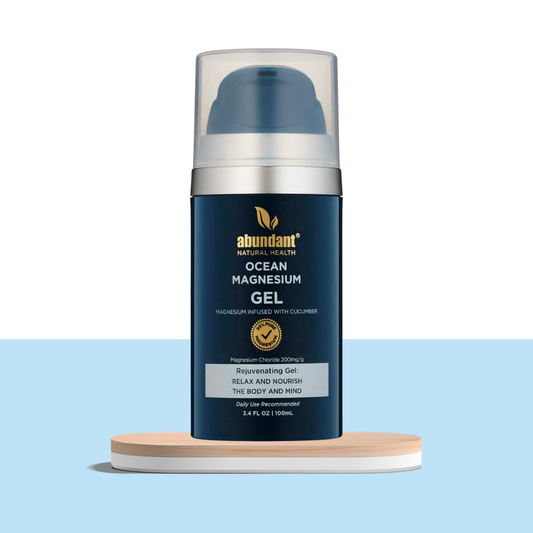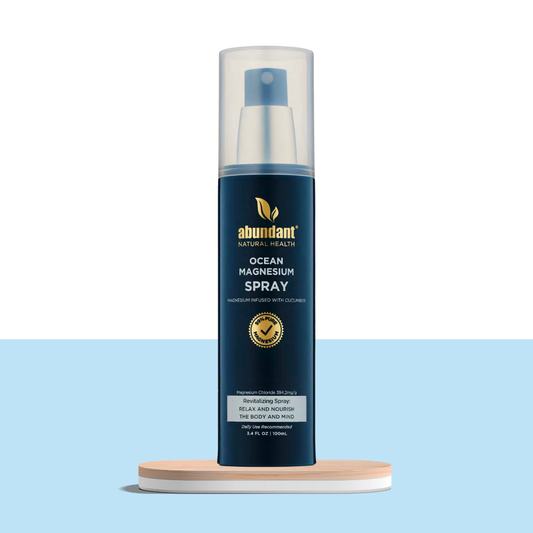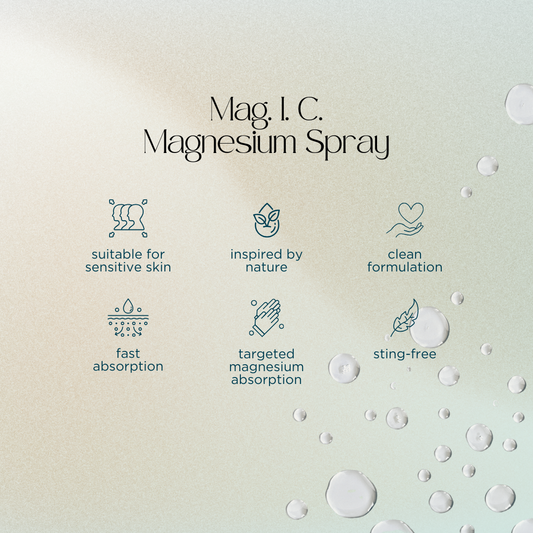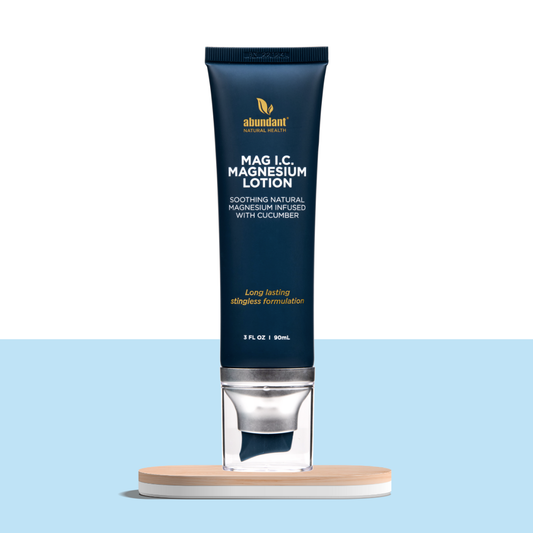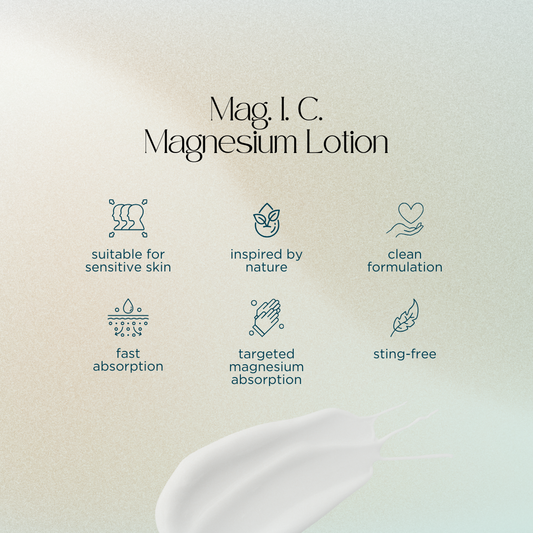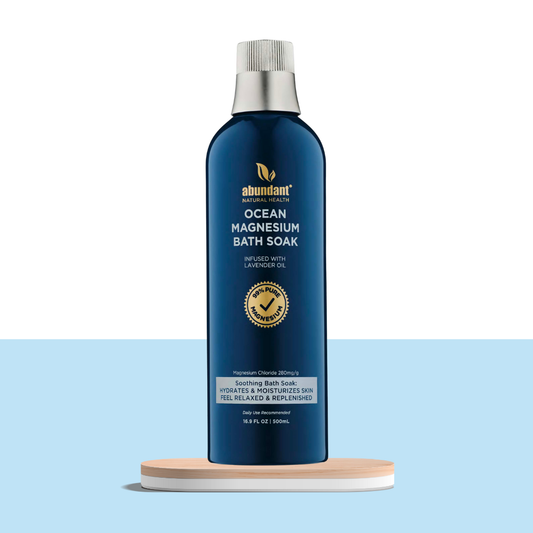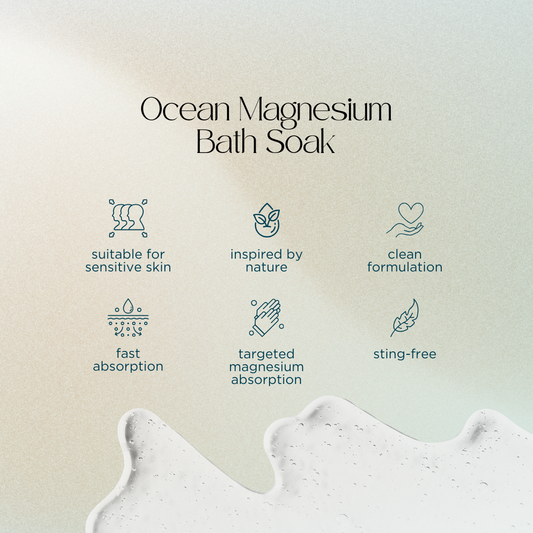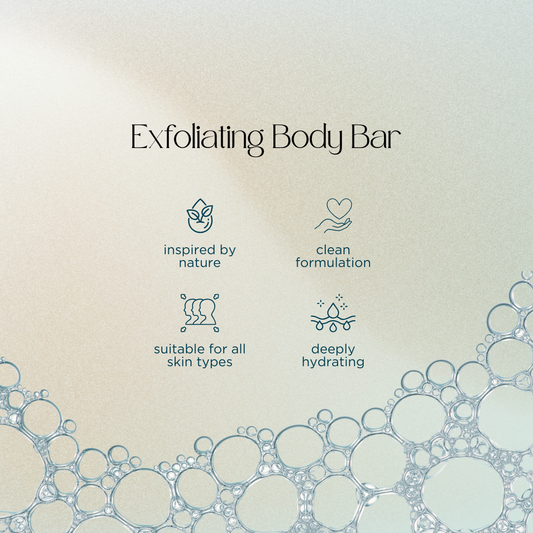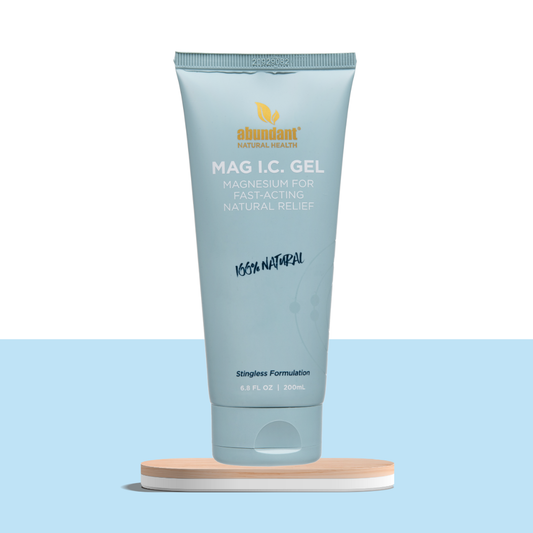Collection: Magnesium Range
Topical Magnesium
What is magnesium?
Magnesium is the 8th most abundant element on earth [1]. It is mined from the earth in minerals such as magnesite and dolomite, but also present in near infinite quantities in the ocean [1]. Without magnesium, life as we know it could not exist. Magnesium plays an important role in the human body and is a cofactor in over 300 enzymes needed in biochemical reactions [2].
Magnesium can be taken orally (through diet or supplements) or applied to the skin (in the form of topical magnesium). Read more about how topical magnesium works in the section 'How does topical magnesium work’
What does magnesium do?
Magnesium is an essential mineral for the daily function of our bodies. Young, old, or in-between, important biological processes such as energy production, fuel utilisation, protein synthesis, muscle and nerve function, bone development, blood pressure and blood glucose regulation are dependent on magnesium balance [3-5].
Many of us don’t get enough magnesium in our diets [6-7]. Low magnesium can be linked to agricultural practices, food processing, cooking [8-9], certain diseases affecting the gastrointestinal tract, as well as caffeine and alcohol consumption [10].
Chronically low levels of magnesium in the body can predispose us to chronic disease including heart disease, high blood pressure, diabetes, osteoporosis (low bone density) and migraines [2]. Therefore, getting your daily fill of magnesium is essential for health and longevity.
What is magnesium glycinate?
Magnesium glycinate is an organic compound used in oral magnesium supplements (rather than topical magnesium formulations) such as Abundant Element – Muscle. Inorganic magnesium compounds (such as magnesium oxide) provide high levels of elemental magnesium, however with low solubility, they can’t be used by the body. Magnesium Glycinate is an amino acid bound, organic magnesium compound.
Glycine is a building block of important proteins and a neurotransmitter (brain chemical), which exerts inhibitory and excitatory effects on processes which control food intake, behaviour, and body homeostasis. As an amino acid, Glycine is needed for protein synthesis and can be used to protect against muscle wasting [11].
Organic magnesium absorbs better in the gut and is more available for use by the body than inorganic magnesium [8, 12-13]. Magnesium Glycinate is gentle on the stomach and well tolerated by the body.
How does topical magnesium work?
Topical magnesium utilises the body’s largest organ, the skin, to facilitate the absorption of this important mineral. The skin is made up of three layers – the epidermis (outermost), dermis and the subcutaneous layer (innermost layer). It contains blood vessels, nerve tissue sweat glands and provides important functions including providing a sensory interface, assisting with temperature regulation, controlling fluid loss, various metabolic functions (such as the creation of vitamin D), and immune system protection.
The skin is not entirely impermeable, meaning substances from inside the body may move in and out. That is topical treatments such as creams, ointments or sprays applied to the skin, can affect what goes on inside the body. Topical magnesium solutions are promising avenues for magnesium supplementation and used widely by holistic health practitioners. Transdermal magnesium is an easy, convenient, inexpensive way of getting your magnesium, while bypassing your gut. Which means… no nasty side effects!
Abundant Natural Health’s Magnesium Range offers all manner of topical magnesium solutions which are infused with natural cucumber acids to open your pores, optimising the absorption of this essential mineral. Here’s how it works:
- The scientific formulation of highly concentrated magnesium and sodium chloride with citric/lactic acid is applied to the skin.
- The citric acid exfoliates the dead skin cells on the dermis to open sweat glands and hair follicles, optimising magnesium absorption.
- Magnesium and sodium chloride penetrate the skin layers below, giving direct, instant, long lasting relief.

Fig 1: diagram of how topical magnesium is absorbed through the skin.
Magnesium benefits
What is magnesium good for?
Topical magnesium is truly versatile and is used in a whole range of applications. Abundant Natural Health’s Magnesium Spray and Gel are scientifically proven to provide relief for:
- Mild joint aches, pain, and soreness
- Symptoms of mild arthritis and osteoarthritis
- Muscle cramps, aches, and soreness
- Muscle cramps, spasms, and twitches
- Mild migraines and tension headaches
- Mild nerve pain/neuralgia
- Disturbed or restless sleep
- Mild anxiety
- Premenstrual tension, menstrual spasms, or cramps
Topical magnesium also promotes health and wellbeing. It also has been proven effective in the following applications:
- Prevent dietary magnesium deficiency
- Support immune system
- Support muscle health, mass, and function
- Promote joint health
- Antiseptic and antimicrobial for minor abrasions/cuts
Some of the benefits to using topical magnesium include:
- Topical absorption bypasses the gut- therefore no gastrointestinal side effects.
- High safety profile
- Relatively inexpensive
- Ease of application
- Proven effective relief
You’ll find yourself reaching for magnesium for just about everything. Wherever you need it, Magnesium is a staple for your medicine cabinet. Abundant Natural Health’s Magnesium Range is Aussie made, with 100% natural, ethically sourced, highly concentrated Magnesium. Combined with cooling cucumber, our Magnesium Range absorbs quickly and with stingless application for effective pain relief.
How to use topical magnesium
Topical magnesium can be applied pretty much anywhere (except for the eyes)! At Abundant Natural Health, we know that not everyone’s needs and preferences for magnesium application are the same, so we have developed a range of magnesium products. Here’s how we recommend you use them:
- Magnesium Gels, such as Abundant Natural Health’s Magnesium Gel are thicker and great for deep tissue massages. Gel ‘holds’ more easily than other forms, and therefore goes a lot ‘further’ due to its consistency, so you don’t have to use too much. In saying this, it may take longer to dry on the skin.
- Magnesium Creams or Lotions are thinner and lighter and can double up as a moisturiser. Abundant Natural Health’s Magnesium Lotion is great for everyday use and help to keep your skin supple and hydrated, while boosting your magnesium.
- Magnesium Sprays are great for fast relief on-the-go. Abundant Natural Health’s Magnesium Spray is a great addition to your sports bag, to help keep your muscles primed and give you a boost right when you need it.
- Magnesium Bath Salts are a wonderful addition to any bath, helping to gently exfoliate and soften the skin. Abundant Natural Health’s Magnesium Bath Soak combines organic certified magnesium, lavender oil and highly concentrated salt leaving your muscles supple and ready for a restorative night’s sleep.
These are not hard and fast rules. Get creative and use topical magnesium in whatever way suits your lifestyle.
How much magnesium is needed daily?
The Recommended Dietary Allowance (RDA) for magnesium depends on your age and gender. In general, adults need 310-420mg of magnesium a day [14].
Magnesium is available in a variety of plant and animal food and drinks (see list below). Only about 30-40% of the magnesium we consume in our diets is absorbed by the body [15-16]. Foods rich in magnesium include [14-15]:
- Green leafy vegetables
- Nuts, seeds, wholegrains
- Fortified breakfast cereals (e.g. shredded wheat, oatmeal)
- Beans (black beans, kidney beans, edamame)
- Tap, mineral & bottled water (can vary from brand to brand)
- And many more…
Up to 50% of the US population is deficient in magnesium [7]. Agricultural practices, poor soil quality, food processing and refining as well as caffeine and alcohol consumption [10] deplete our bodies of this important mineral. The average western diet does not support our physiological need for magnesium, and this is where Abundant Natural Health’s topical Magnesium Range can help to boost your magnesium.
How to increase your topical magnesium absorption?
How do you make the most of your topical magnesium products? Optimising your transdermal magnesium absorption can be achieved in several ways:
- Apply more product over a greater skin surface area & use liberally.
- Use the product more frequently throughout the day. We recommend using topical magnesium preventatively to ‘take the edge off’.
- Leave the product on the skin for a longer period. That is, try to shower before applying topical magnesium products.
- Apply to warm, supple, clean areas of skin.
- Use proven effective topical magnesium products.
Read more about how to use different types of topical magnesium in the section How to use topical magnesium’.
Can you have too much magnesium?
Since magnesium is only retained for the immediate needs of the body, excess of the mineral is excreted by the kidneys [12]. This means that the body will only keep what is required and there is little opportunity to ‘overdose’ on magnesium (unless you have a medical condition inhibiting excretion, such as certain kidney diseases).
Having said this, cases of magnesium toxicity can occur with intakes of more than 5000 mg/day of magnesium. So, keep this in mind when using oral supplements with large amounts of magnesium.
Magnesium side effects
High amounts of magnesium from dietary supplements or medication can result in an unpleasant laxative effect - causing nausea, abdominal cramping, and diarrhea [14]. One of the benefits of topical magnesium is that it bypasses the gut, and therefore has little to no side effects, except for the potential for mild local skin irritation. It has antiseptic properties and may also sting when applied to a cut or abrasion. This a one of the great advantages to using topical magnesium in addition to magnesium you may get from dietary sources and oral supplements.
Can you take magnesium when pregnant?
Absolutely! In fact, when pregnant you require up to 40mg more magnesium a day to support your and your baby’s needs [14].
If you’re worried about taking supplements, topical magnesium is a great way prevent dietary nutrient deficiency. Topical magnesium is also a targeted treatment for mild muscle and joint aches and pains, muscles cramps and spasms, mild headaches/migraines, and calming the mind for a quality night’s sleep. See section entitled What is magnesium good for? for the full list of topical magnesium benefits.
Pregnancy is not only physically, but emotionally taxing. Feel more like yourself again with topical magnesium from Abundant Natural Health’s Magnesium Range, which is 100% natural and safe to use during pregnancy. Soak your cares away with our Magnesium Bath Soak and exfoliate your skin with our Exfoliating Body Bar. Following your bath liberally massage Magnesium Lotion or Magnesium Gel into your aching back, tired legs, feet, or any areas of tenderness for instant relief, with no nasty side effects.
Australian Made Magnesium
Built on a foundation of science, Abundant Natural Health is 100% Australian grown, owned and made with sustainable and ethically sourced ingredients.
We partner with EcoMag to ensure our customers receive the worlds purest magnesium (99.5% purity), sustainably sourced from our infinite supply off the coast of Western Australia. Using cutting edge processes and technology, we create eco-friendly products which are mindful of the environment ensuring a better place for future generations.
Abundant Natural Health’s Magnesium Range is concentrated with high purity, quality organic certified magnesium. Use Abundant Natural Health today for a superior quality, highly effective, ethically sourced, and sustainable topical magnesium.
References
- Royal Society of Chemistry. (2022). Magnesium. Retrieved from https://www.rsc.org/periodic-table/element/12/magnesium#:~:text=Magnesium%20is%20the%20eighth%20most,tonnes%20now%20produced%20each%20year. Accessed 14 March 2022.
- National Institutes of Health Office of Dietary Supplements. (2022) Magnesium Fact Sheet for Health Professionals. Retrieved from https://ods.od.nih.gov/factsheets/Magnesium-HealthProfessional/#:~:text=Magnesium%20is%20a%20cofactor%20in,%2C%20oxidative%20phosphorylation%2C%20and%20glycolysis. Accessed 14 March 2022.
- Aikawa, J. K. (1982). Magnesium: Its biological significance. Boca Raton. Fla., 1981.
- Swaminathan, R. (2003). Magnesium metabolism and its disorders. The Clinical Biochemist Reviews, 24(2), 47.
- Saris, N. E. L., Mervaala, E., Karppanen, H., Khawaja, J. A., & Lewenstam, A. (2000). Magnesium: an update on physiological, clinical and analytical aspects. Clinica chimica acta, 294(1-2), 1-26.
- Australian Bureau of Statistics (ABS). (2015). Australian Health Survey: Usual Nutrient Intakes. Retrieved from: https://www.abs.gov.au/statistics/health/health-conditions-and-risks/australian-health-survey-usual-nutrient-intakes/latest-release. Accessed 18 Jan 2021.
- Uwitonze, A. M., & Razzaque, M. S. (2018). Role of magnesium in vitamin D activation and function. J Am Osteopath Assoc, 118(3), 181-189.
- Uysal, N., Kizildag, S., Yuce, Z., Guvendi, G., Kandis, S., Koc, B., ... & Ates, M. (2019). Timeline (bioavailability) of magnesium compounds in hours: which magnesium compound works best?. Biological trace element research, 187(1), 128-136.
- DiNicolantonio, J. J., O’Keefe, J. H., & Wilson, W. (2018). Subclinical magnesium deficiency: a principal driver of cardiovascular disease and a public health crisis. Open heart, 5(1), e000668.
- Naithani, M., Bharadwaj, J., & Darbari, A. (2014). Magnesium: The fifth electrolyte. Journal of Medical Nutrition and Nutraceuticals, 3(2), 66.
- Koopman, C. (2017). Glycine metabolism in skeletal muscle: implications for metabolic homeostasis. Current Opinion in Clinical Nutrition and Metabolic Care, 20(4), 237–242. https://doi.org/10.1097/MCO.0000000000000383
- Schuchardt, J., & Hahn, A. (2017). Intestinal absorption and factors influencing bioavailability of magnesium-an update. Current Nutrition & Food Science, 13(4), 260-278.
- Coudray, C., Rambeau, M., Feillet-Coudray, C., Gueux, E., Tressol, J. C., Mazur, A., & Rayssiguier, Y. (2005). Study of magnesium bioavailability from ten organic and inorganic Mg salts in Mg-depleted rats using a stable isotope approach. Magnesium research, 18(4), 215-223.
- Institute of Medicine (IOM). (1997). Dietary Reference Intakes: Calcium, Phosphorus, Magnesium, Vitamin D and Fluoride. Washington, DC: National Academy Press.
- Rude R.K. (2010). Magnesium. Encyclopedia of Dietary Supplements. 2nd ed. New York, NY: Informa Healthcare.
- Fine, K. D., Santa Ana, C. A., Porter, J. L., & Fordtran, J. S. (1991). Intestinal absorption of magnesium from food and supplements. The Journal of clinical investigation, 88(2), 396-402.
Disclaimer: This site does not provide medical advice. The author is not a medical professional, dietician, or nutritionist. This website is intended for informational purposes only and it is not a substitute for professional medical advice, diagnosis, or treatment. By providing the information contained herein we are not diagnosing, treating, curing, mitigating, or preventing any type of disease of medical condition. Patients should not use the information contained on this website to self-diagnose or self-treat any health-related condition. Never ignore professional medical advice in seeking treatment because of something you have read on this website. Before beginning any type of natural, integrative, or conventional treatment regimen, it is advisable to seek the advice of a licensed healthcare professional. Information is gathered and shared from reputable sources; however, Abundant Natural Health is not responsible for errors or omissions in reporting or explanation.
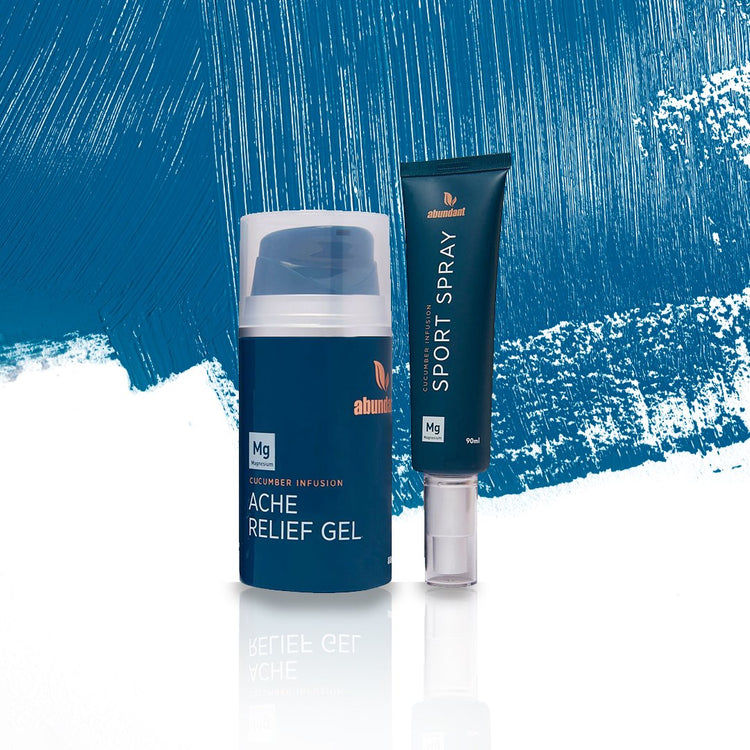
-
Ocean Magnesium Gel (100mL/3.4oz)
Regular price $18.99 USDRegular priceUnit price / per -
Ocean Magnesium Spray (100mL/3.4oz)
Regular price $18.99 USDRegular priceUnit price / per -
MAG I.C. Magnesium Lotion (90mL/3oz)
Regular price $17.59 USDRegular priceUnit price / per -
Magnesium Bath Soak (500mL/16.9oz)
Regular price $19.99 USDRegular priceUnit price / per -
Magnesium Exfoliating Body Bar 90g
Regular price $10.99 USDRegular priceUnit price / per -
MAG I.C. Gel (200mL/6.8oz)
Regular price $14.00 USDRegular priceUnit price / per

